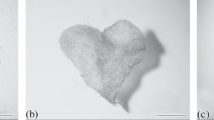Summary
Gametophytes of six species of the family Schizaeaceae were exposed to gibberellins. In all six species gibberellin can replace the natural hormones inducing the formation of antheridia (antheridogens). This process of cell differentiation was analyzed in detail in gametophytes of Anemia phyllitidis.
After an induction by gibberellic acid the formation of antheridia is preceded by a slow-down of the rate of cell division.
The induction of antheridia is possible only after a certain state of development of the prothalli has been reached. This critical physiological age is highest at lowest gibberellin concentrations. The relationship can be characterized by a “critical cell number” (as defined in the paper).
This criterion is independent of the growth rate of the gametophytes.
The close correlation between hormone titer and time of induction indicates an at least change is sensitivity toward gibberellins in certain defined regions of the prothalli during the course of ontogenesis. With increasing physiological age an increase in sensitivity has been measured.
Zusammenfassung
Bei allen untersüchten Gametophyten der Schizaeaceen (6 Arten) können die nativen, für die Auslösung der Antheridienbildung verant-wortlichen Hormone (Antheridogene) durch Gibberelline ersetzt werden. Eine Analyse dieses Zelldifferenzierungsprozesses wurde an Prothallien von Anemia phyllitidis durchgeführt.
Die durch Gibberelline ausgelöste Umdifferenzierung vegetativer Zellen zu Antheridienmutterzellen wird durch eine Reduktion der Zellteilungsrate eingeleitet.
Voraussetzung für die Auslösung der Antheridienbildung ist das Erreichen eines bestimmten Entwicklungszustands der Prothallien. Dieses physiologische Alter ist um so höher, je geringer die applizierte Gibberellinkonzentration ist. Als Kennwert dieser Wechselbeziehung wurde eine „kritische Zellzahl” definiert.
Diese kritische Zellzahl ist weitgehend unabhängig von der Wachstumsgeschwindigkeit der Prothallien.
Die enge Korrelation zwischen Hormontiter und Zeitpunkt der Antheridienanlage beruht zumindest teilweise auf einer Sensibilitätsänderung definierter Prothalliumbereiche gegenüber Gibberellinen im Verlauf der Ontogenese. Eine mit dem physiologischen Alter zunehmende Empfindlichkeit konnte nachgewiesen werden.
Similar content being viewed by others
Literatur
Döpp, W.: Eine die Antheridienbildung fördernde Substanz in den Prothallien von Pteridium aquilinum (L.) Kuhn. Ber. dtsch. bot. Ges. 63, 139–147 (1950).
—: über eine fördernde und eine hemmende Substanz bei der Antheridienbildung in den Prothallien von Pteridium aquilinum. Ber. dtsch. bot. Ges. 72, 11–24 (1959).
—: Weitere Untersuchugen über die Physiologie der Antheridienbildung bei Pteridium aquilinum. Planta (Berl.) 58, 483–508 (1962).
Kato, Y.: Responses of plant cells to gibberellin. Bot. Gaz. 117, 16–24 (1955).
—, W.K. Purves, and B.O. Phinney: Gibberellin-like substances in plants. Nature (Lond.) 196, 687–688 (1961).
Kelley, A.G., and S.N. Postlethwait: Effect of 2-chloräthyltrimethylammonium chloride on fern gametophytes. Amer. J. Bot. 49, 778–786 (1962).
Klebs, G.: Über Probleme der Entwicklung. Biol. Zbl. 24, 444–614 (1904).
Knobloch, J.W.: Gibberellic acid and ferns. Amer. Fern J. 47, 134 (1957).
Mohr, H.: Die Abhängigkeit des Protonemawachstums und der Protonemapolarität bei Farnen vom Licht. Planta (Berl.) 47, 127–158 (1956).
Naef, U.: Controle of antheridium formation in the fern species Anemia phyllitidis. Nature (Lond.) 184, 798–800 (1959).
—: On the controle of antheridium formation in the fern species Lygodium japonicum. Proc. Soc. exp. Biol. (N. Y.) 105, 82–86 (1960).
—: On the physiology of antheridium formation in ferns. Proc. 4th Internat. Conf. Plant Growth Reg., p. 709–723. Ames: Iowa State Univ. Press 1961a).
—: Mode of an antheridium inducing substance in ferns. Nature (Lond.) 189, 900–903 (1961b).
—: Developmental physiology of lower archegoniates. Ann. Rev. Plant Physiol. 13, 507–532 (1962a).
—: Loss of sensitivity to the antheridial factor in maturing gametophytes of the fern Onoclea sensibilis. Phyton (Argent.) 18, 173–182 (1962b).
Pringle, R.B.: Chemical structure of antheridogen A, a specific inducer of the male sex organ in certain fern species. Science 133, 173–187 (1961).
Schraudolf, H.: Die Wirkung von Phytohormonen auf Keimung und Entwicklung von Farnprothallien. I. Auslösung der Antheridienbildung und Dunkelkeimung bei Schizaeaceen durch Gibberellinsäure. Biol. Zbl. 81, 731–740 (1962).
—: Relative activity of the gibberellins in the antheridium induction in Anemia phyllitidis. Nature (Lond.) 201, 98–99 (1964).
Voeller, B.: Antheridogens in ferns. Régulateurs naturels de la croissance végétale, p. 665–684. Gif s/Yvette, Paris 1964.
Witsch, H.v., u. J. Rintelen: Die Entwicklung von Farnprothallien unter Gibberellineinflß. Planta (Berl.) 59, 115–118 (1962).
Author information
Authors and Affiliations
Rights and permissions
About this article
Cite this article
Schraudolf, H. Die Wirkung von Phytohormonen auf Keimung und Entwicklung von Farnprothallien. Planta 68, 335–352 (1966). https://doi.org/10.1007/BF00386333
Received:
Issue Date:
DOI: https://doi.org/10.1007/BF00386333




